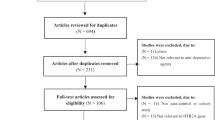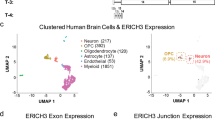Abstract
Tetrahydrobiopterin (BH4) is an essential cofactor for synthesis of many neurotransmitters including serotonin. In serotonergic neurons, BH4 is tightly regulated by GTP-cyclohydrolase I feedback regulator (GFRP). Given the pivotal role of the serotonergic system in mood disorders and selective serotonin reuptake inhibitors (SSRIs) antidepressant function, we tested the hypothesis that GFRP gene (GCHFR) variants would modify response to antidepressants in subjects with major depression. Two single nucleotide polymorphisms (rs7164342 and rs7163862) in the GCHFR promoter were identified and occurred as two haplotypes (GA or TT). A multiple regression analysis revealed that homozygous individuals for the TT haplotype were less likely to respond to the SSRI fluoxetine than to the tricyclic antidepressant nortriptyline (P=0.037). Moreover, the TT haplotype showed a reduced transcription rate in luciferase reporter gene assays, which may impact on BH4-mediated neurotransmitter production, thus suggesting a biological process through which GCHFR promoter variants might influence antidepressant response.
This is a preview of subscription content, access via your institution
Access options
Subscribe to this journal
Receive 6 print issues and online access
$259.00 per year
only $43.17 per issue
Buy this article
- Purchase on Springer Link
- Instant access to full article PDF
Prices may be subject to local taxes which are calculated during checkout


Similar content being viewed by others
References
Nagatsu T, Ichinose H . Regulation of pteridine-requiring enzymes by the cofactor tetrahydrobiopterin. Mol Neurobiol 1999; 19: 79–96.
Ohue T, Koshimura K, Lee K, Watanabe Y, Miwa S . A novel action of 6R-L-erythro-5,6,7,8-tetrahydrobiopterin, a cofactor for hydroxylases of phenylalanine, tyrosine and tryptophan: enhancement of acetylcholine release in vivo in the rat hippocampus. Neurosci Lett 1991; 128: 93–96.
Miwa S, Watanabe Y, Koshimura K, Masaki T . [A novel function of tetrahydrobiopterin]. Nippon Yakurigaku Zasshi 1992; 100: 367–381.
McHugh PC, Joyce PR, Kennedy MR . Polymorphisms of sepiapterin reductase gene alter promoter activity and may influence risk of bipolar disorder. Pharmacogenet Genomics 2009; 19: 330–337.
Curtius HC, Niederwieser A, Levine RA, Lovenberg W, Woggon B, Angst J . Successful treatment of depression with tetrahydrobiopterin. Lancet 1983; 1: 657–658.
Miura H, Qiao H, Kitagami T, Ohta T . Fluvoxamine, a selective serotonin reuptake inhibitor, suppresses tetrahydrobiopterin in the mouse hippocampus. Neuropharmacology 2004; 46: 340–348.
Miura H, Kitagami T, Ozaki N . Suppressive effect of paroxetine, a selective serotonin uptake inhibitor, on tetrahydrobiopterin levels and dopamine as well as serotonin turnover in the mesoprefrontal system of mice. Synapse 2007; 61: 698–706.
Hashimoto R, Nagatsu T, Ohta T, Mizutani M, Omura I . Changes in the concentrations of tetrahydrobiopterin, the cofactor of tyrosine hydroxylase, in blood under physical stress and in depression. Ann NY Acad Sci 2004; 1018: 378–386.
Hashimoto R, Mizutani M, Ohta T, Nakazawa K, Nagatsu T . Changes in plasma tetrahydrobiopterin levels of depressives in depressive and remission phases: reconfirmed by measurement with an internal standard. Neuropsychobiology 1994; 29: 57–60.
Abou-Saleh MT, Anderson DN, Collins J, Hughes K, Cattell RJ, Hamon CG et al. The role of pterins in depression and the effects of antidepressive therapy. Biol Psychiatry 1995; 38: 458–463.
McQuillin A, Rizig M, Gurling HM . A microarray gene expression study of the molecular pharmacology of lithium carbonate on mouse brain mRNA to understand the neurobiology of mood stabilization and treatment of bipolar affective disorder. Pharmacogenet Genomics 2007; 17: 605–617.
McHugh PC, Rogers GR, Loudon B, Glubb DM, Joyce PR, Kennedy MA . Proteomic analysis of embryonic stem cell-derived neural cells exposed to the antidepressant paroxetine. J Neurosci Res 2008; 86: 306–316.
Brandish PE, Su M, Holder DJ, Hodor P, Szumiloski J, Kleinhanz RR et al. Regulation of gene expression by lithium and depletion of inositol in slices of adult rat cortex. Neuron 2005; 45: 861–872.
Harada T, Kagamiyama H, Hatakeyama K . Feedback regulation mechanisms for the control of GTP cyclohydrolase I activity. Science 1993; 260: 1507–1510.
Kapatos G, Hirayama K, Shimoji M, Milstien S . GTP cyclohydrolase I feedback regulatory protein is expressed in serotonin neurons and regulates tetrahydrobiopterin biosynthesis. J Neurochem 1999; 72: 669–675.
Yoneyama T, Wilson LM, Hatakeyama K . GTP cyclohydrolase I feedback regulatory protein-dependent and -independent inhibitors of GTP cyclohydrolase I. Arch Biochem Biophys 2001; 388: 67–73.
Ciulla TA, Sklar RM, Hauser SL . A simple method for DNA purification from peripheral blood. Anal Biochem 1988; 174: 485–488.
Thony B, Auerbach G, Blau N . Tetrahydrobiopterin biosynthesis, regeneration and functions. Biochem J 2000; 347 (Part 1): 1–16.
McHugh PC, Joyce PR, Kennedy MA . Polymorphisms of sepiapterin reductase gene alter promoter activity and may influence risk of bipolar disorder. Pharmacogenet Genomics 2009; 19: 330–337.
White LA, Eaton MJ, Castro MC, Klose KJ, Globus MY, Shaw G et al. Distinct regulatory pathways control neurofilament expression and neurotransmitter synthesis in immortalized serotonergic neurons. J Neurosci 1994; 14: 6744–6753.
Joyce PR, Mulder RT, Luty SE, Sullivan PF, McKenzie JM, Abbott RM et al. Patterns and predictors of remission, response and recovery in major depression treated with fluoxetine or nortriptyline. Aust NZ J Psychiatry 2002; 36: 384–391.
Spitzer RL, Williams JB, Gibbon M, First MB . The Structured Clinical Interview for DSM-III-R (SCID). I: history, rationale, and description. Arch Gen Psychiatry 1992; 49: 624–629.
Hamilton M . A rating scale for depression. J Neurol Neurosurg Psychiatry 1960; 23: 56–62.
Montgomery SA, Asberg M . A new depression scale designed to be sensitive to change. Br J Psychiatry 1979; 134: 382–389.
Sheehan DV, Lecrubier Y, Sheehan KH, Amorim P, Janavs J, Weiller E et al. The Mini-International Neuropsychiatric Interview (MINI): the development and validation of a structured diagnostic psychiatric interview for DSM-IV and ICD-10. J Clin Psychiatry 1998; 59 (Suppl 20): 22–33; quiz 34–57.
Steinberg M . Interviewers Guide to the Structured Clinical Interview for DSM-IV Dissociative Disorders (SCID-D). American Psychiatric Press: Washington, DC, 1994.
Hirschfeld RM, Williams JB, Spitzer RL, Calabrese JR, Flynn L, Keck Jr PE et al. Development and validation of a screening instrument for bipolar spectrum disorder: the Mood Disorder Questionnaire. Am J Psychiatry 2000; 157: 1873–1875.
Light KJ, Joyce PR, Luty SE, Mulder RT, Frampton CM, Joyce LR et al. Preliminary evidence for an association between a dopamine D3 receptor gene variant and obsessive-compulsive personality disorder in patients with major depression. Am J Med Genet B Neuropsychiatr Genet 2006; 141: 409–413.
Shi YY, He L . SHEsis, a powerful software platform for analyses of linkage disequilibrium, haplotype construction, and genetic association at polymorphism loci. Cell Res 2005; 15: 97–98.
Briley M, Moret C . Neurobiological mechanisms involved in antidepressant therapies. Clin Neuropharmacol 1993; 16: 387–400.
Acknowledgements
RN46A cells were a kind gift from Scott Whittemore, Laboratory of Molecular Neurobiology, Louisville, KY, USA. This work was supported by grants from the Health Research Council of New Zealand, Canterbury Medical Research Foundation.
Author information
Authors and Affiliations
Corresponding author
Ethics declarations
Competing interests
The authors declare no conflict of interest.
Additional information
Supplementary Information accompanies the paper on The Pharmacogenomics Journal website
Supplementary information
Rights and permissions
About this article
Cite this article
McHugh, P., Joyce, P., Deng, X. et al. A polymorphism of the GTP-cyclohydrolase I feedback regulator gene alters transcriptional activity and may affect response to SSRI antidepressants. Pharmacogenomics J 11, 207–213 (2011). https://doi.org/10.1038/tpj.2010.23
Received:
Revised:
Accepted:
Published:
Issue Date:
DOI: https://doi.org/10.1038/tpj.2010.23



